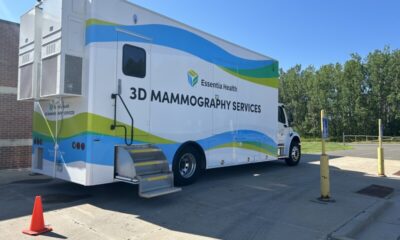Education
Community Collaborates to Boost Literacy Rates by 2028

Children’s reading skills are essential for their cognitive, emotional, and social development. Recent research shows that effective instructional methods can help as many as 95% of students attain reading proficiency. Early intervention is particularly crucial, as strategies implemented before third grade significantly enhance students’ chances of meeting critical literacy benchmarks. By the time students reach third grade, education transitions to using reading as a tool for learning across subjects, making proficiency in reading vital for future academic success.
At a meeting on June 3, 2023, the Williamsburg-James City County School Board assessed literacy and assessment initiatives aimed at achieving an 85% K–12 grade-level reading proficiency rate by 2028. Currently, about 1,650 students in the district are reading below grade level. The board discussed the Virginia Literacy Act and the VALS assessment framework, focusing on targeted interventions and ongoing data analysis to inform instructional changes and resource allocation.
Understanding literacy extends beyond traditional reading and writing skills. It encompasses the ability to acquire, interpret, and effectively use information. Proficiency in literacy not only promotes informed decision-making but also enhances civic engagement. The Annie E. Casey Foundation Report highlights that students who do not achieve reading proficiency by the end of third grade are at a higher risk of dropping out of high school. This underscores the need for continuous assessment and collaborative efforts between schools and communities to address literacy challenges.
Dyslexia is a significant barrier to literacy, affecting an estimated 15-20% of the population regardless of intelligence. More frequently diagnosed in boys, dyslexia can impair reading, writing, and spelling abilities, leading to challenges in organizational and academic performance. Early and accurate diagnosis, coupled with evidence-based instructional strategies, is vital for supporting these students. Unfortunately, dyslexia is likely underreported across various demographic groups in the United States, making awareness and support crucial for effective intervention.
Technological advancements, particularly in artificial intelligence, are playing an increasingly important role in assisting individuals with dyslexia and related learning challenges. AI tools can streamline academic tasks, reduce disruptions, and promote persistence in learning. These technologies offer support in grammar, spelling, reading, and mathematics, enhancing the educational experience for those affected.
Higher literacy levels correlate with improved academic performance, better employment opportunities, and enhanced community well-being. Strong literacy skills empower individuals to navigate everyday tasks such as understanding medical instructions and managing finances. Moreover, research indicates that higher literacy is linked to increased earnings and economic security. In contrast, insufficient reading proficiency by third grade is associated with lower graduation rates, particularly among low-income populations.
Community-based literacy programs are essential in addressing local literacy needs. These initiatives provide family learning opportunities, structured curricula, and partnerships with businesses to offer resources and training. Literacy for Life has been serving the Williamsburg area for over 45 years, focusing on helping individuals develop essential literacy skills. Their programs aim to raise literacy rates, address disparities linked to limited opportunities, and support socioeconomic development within the community.
Glenn Marshall, a resident of Williamsburg and retired from Newport News Shipbuilding, is actively involved in literacy efforts. As someone who has experienced dyslexia, he volunteers with career pathways programs and serves on the regional board for the Association for Manufacturing Excellence, which spans 13 states. His leadership focuses on ensuring that individuals graduate with the literacy and skills needed to thrive in their careers.
As communities work together to enhance literacy rates, the importance of ongoing support, intervention, and collaboration cannot be overstated. By prioritizing literacy, communities can create a foundation for academic and economic success, transforming lives and futures for generations to come.
-

 Technology5 months ago
Technology5 months agoDiscover the Top 10 Calorie Counting Apps of 2025
-

 Technology3 weeks ago
Technology3 weeks agoOpenAI to Implement Age Verification for ChatGPT by December 2025
-

 Health3 months ago
Health3 months agoBella Hadid Shares Health Update After Treatment for Lyme Disease
-

 Health3 months ago
Health3 months agoAnalysts Project Stronger Growth for Apple’s iPhone 17 Lineup
-

 Health4 months ago
Health4 months agoErin Bates Shares Recovery Update Following Sepsis Complications
-

 Technology5 months ago
Technology5 months agoDiscover How to Reverse Image Search Using ChatGPT Effortlessly
-

 Technology3 months ago
Technology3 months agoElectric Moto Influencer Surronster Arrested in Tijuana
-

 Technology5 months ago
Technology5 months agoMeta Initiates $60B AI Data Center Expansion, Starting in Ohio
-

 Technology2 months ago
Technology2 months agoDiscover 2025’s Top GPUs for Exceptional 4K Gaming Performance
-

 Technology5 months ago
Technology5 months agoRecovering a Suspended TikTok Account: A Step-by-Step Guide
-

 Health5 months ago
Health5 months agoTested: Rab Firewall Mountain Jacket Survives Harsh Conditions
-

 Lifestyle5 months ago
Lifestyle5 months agoBelton Family Reunites After Daughter Survives Hill Country Floods





















